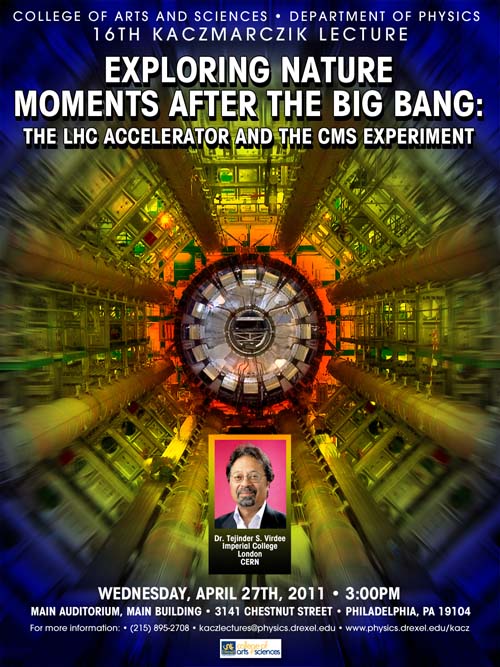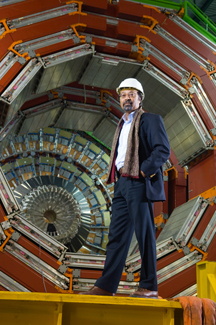16th Kaczmarczik Lecture
"Exploring Nature Moments after the Big Bang:
The LHC Accelerator and the CMS Experiment"
Tejinder S. Virdee, PhD
Imperial College, London, CERN
Wednesday, April 27, 2011
3:00 p.m.
Main Auditorium
3141 Chestnut Street
Philadelphia, PA 19104
 The LHC project, comprising the accelerator and the experiments, aims to tackle some of the most fundamental questions about the origin, evolution and composition of our universe. Potential discoveries include new forms of matter, new forces of nature, new dimensions of space and time. Particular questions to be addressed include: what is the origin of mass, what constitutes dark matter, why is the universe composed of matter, not antimatter, and more. The discoveries have the potential to alter our perception of how Nature operates at the fundamental level.
The LHC project, comprising the accelerator and the experiments, aims to tackle some of the most fundamental questions about the origin, evolution and composition of our universe. Potential discoveries include new forms of matter, new forces of nature, new dimensions of space and time. Particular questions to be addressed include: what is the origin of mass, what constitutes dark matter, why is the universe composed of matter, not antimatter, and more. The discoveries have the potential to alter our perception of how Nature operates at the fundamental level.
In 2010, the LHC accelerator collided protons and lead ions at unprecedented high energies. Outstanding progress was made in operating the accelerator with very good performance.
The Compact Muon Solenoid (CMS) experiment, one of the two large general-purpose experiments, also performed very well, close to the ambitious design performance set down some fifteen years ago. Physics measurements are confronting, more and more precisely, the predictions of the Standard Model of particle physics, whilst looking for new physics.
CMS is designed to operate in a very harsh environment created by hundreds of billions of particles produced every second, and to register with high accuracy the passage and energies of all these particles. Thus, this demands huge data collection, transfer and processing rates on a scale greater than ever previously attempted. CMS comprises over 3500 scientists and engineers from over 180 institutions in 38 countries.
This talk will briefly recall the physics of the LHC, outline some of the challenges faced during the construction of the accelerator and CMS, their operation and performance, the first physics results, and the outlook.
For more information:
(215) 895-2708
kaczlectures@physics.drexel.edu
 Tejinder (Jim) Virdee is Professor of Physics at Imperial College, London. He did his graduate studies at Imperial College on an experiment conducted at the Stanford Linear Accelerator Centre, Stanford. He has worked on an experiment studying deep inelastic Compton scattering of photons off of quarks and then on the UA1 proton-antiproton collider experiment, both at CERN. The UA1 experiment discovered the W and Z bosons. This discovery merited a Nobel prize for UA1 spokesperson Carlo Rubbia, and machine physicist Simon van der Meer. After the termination of UA1 (1990), Dr. Virdee concentrated on the physics of, and experimentation at, the next generation of hadron colliders. He is one of the founding members of the Compact Muon Solenoid Collaboration (CMS) at CERN-LHC. Dr. Virdee has played a major role in all phases of the experiment. These phases have lasted around 20 years and include the formation of CMS, the definition of the physics goals, checking performance against benchmark physics reactions, detector R&D, detector prototyping, construction and installation, commissioning, data-taking and the start of the extraction of science. Dr. Virdee was the Spokesperson (leader) of the CMS Collaboration for three years between 2007 to 2009, and was the Deputy Spokesperson of CMS from 1993 to 2006.
Tejinder (Jim) Virdee is Professor of Physics at Imperial College, London. He did his graduate studies at Imperial College on an experiment conducted at the Stanford Linear Accelerator Centre, Stanford. He has worked on an experiment studying deep inelastic Compton scattering of photons off of quarks and then on the UA1 proton-antiproton collider experiment, both at CERN. The UA1 experiment discovered the W and Z bosons. This discovery merited a Nobel prize for UA1 spokesperson Carlo Rubbia, and machine physicist Simon van der Meer. After the termination of UA1 (1990), Dr. Virdee concentrated on the physics of, and experimentation at, the next generation of hadron colliders. He is one of the founding members of the Compact Muon Solenoid Collaboration (CMS) at CERN-LHC. Dr. Virdee has played a major role in all phases of the experiment. These phases have lasted around 20 years and include the formation of CMS, the definition of the physics goals, checking performance against benchmark physics reactions, detector R&D, detector prototyping, construction and installation, commissioning, data-taking and the start of the extraction of science. Dr. Virdee was the Spokesperson (leader) of the CMS Collaboration for three years between 2007 to 2009, and was the Deputy Spokesperson of CMS from 1993 to 2006.
Dr. Virdee was awarded the 2009 James Chadwick Medal and Prize of the U. K. Institute of Physics for his crucial role in the design and construction of CMS.
High School Open House Program:
12:00 - 12:30 pm - Main Auditorium - Main Building
12:30 - 2:30 pm - Department of Physics Open House
Brief presentations on Biophysics, Astrophysics, Computational Physics, Condensed Matter, Nonlinear Dynamics, Particle Physics, etc. An excellent opportunity for high school students to visit our laboratories and meet in person with our internationally recognized researchers.
2:30 - 3:00 pm - Reception
About the Kaczmarczik Lecture
Paul Kaczmarczik began his career as a Professor of Physics at Drexel University in 1953. A key player in building the Physics and Atmospheric Science Department, he made important contributions to teaching at Drexel University during his many years of service. Well-liked by both his colleagues and his students, Professor Kaczmarczik became Professor Emeritus in 1989. The Kaczmarczik Lecture Series was established in 1995 in honor of Professor Kaczmarczik. It brings to Drexel outstanding scientists to present lectures on topics at the cutting edge of Physics research.